Many Moabites were not quick to embrace the Mountain Bike Phenomenon. Local businesses geared to tourism were the first to see the benefit and tolerated the invasion, if not fully embracing it. Old Moab was not so generous. These guys had been wearing the same worn out Wranglers and snap-front shirts and weathered straw hats since 1952. To suddenly see their Main Street, cluttered with men in tights (and royal blue at that) rankled worse than an unshaved hippie. Confrontation was inevitable.
For a few years, the Culture Clash between Old and New Moab even grew violent at times. Moab teenagers, full of testosterone and a six pack of beer, tried to amuse themselves at the hapless bikers’ expense. Turned loose for the first time in their fathers’ pickups, and carrying an earful of their fathers’ anti-bike rhetoric as well, the kids sometimes harassed the bikers, ran them off the street and even collided with them on occasion. A few Neophyte/Moabites were arrested and charged and for a while, Moab gained a reputation for bicycle intolerance.
But the money was just too good to even let prejudice and bad behavior interfere. And it wasn’t just the tourist shops and restaurants that benefitted. Again the Forces in the Universe came into play with perfect synchronicity.
Three factors affected Moab’s destiny; two of them were physical realities and the third was a metaphysical notion. One played off the other two and what sallied forth from it is the Moab we have today.
First was that feeling that change was coming to Moab in unimagined ways. We knew about the mountain bikes, had experienced both the excitement and dismay that it caused, but we wondered how a few Lycra-clad bicyclists could alter the course of history.
Moab was in a state of economic depression that spring; the Atlas mill was shut down, miners and their families had abandoned Moab in droves, in search of employment elsewhere and left their homes behind, hoping a realtor could salvage at least a part of their investment.
The vanguard of mountain bikers were from places like California and Colorado, generally young urban professionals, extremely affluent, and always in search of a good investment. What none of them could fail to notice as they wheeled their way through the streets of town toward the Sand Flats or the River Road was the extraordinary number of “for sale” signs that lined almost every residential street. Sometimes it appeared as if the entire neighborhood was on the block.
Inevitably one of those bikers came back early from a ride and looked up a local realtor and inquired about prices. Whoever it was must not have been able to believe his ears or his good fortune. Every kind of home was on the market, from modest one bedroom cottages to luxurious five bedroom mansions. But a small home that might have sold for $50,000 just five years earlier now could be had for less than half.
Word spread like ticks on a reservation dog.
It almost became a joke. Coloradans and Californians, who traveled here merely to experience the new sport of 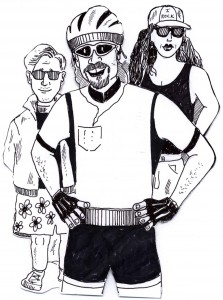 mountain biking on some unique terrain, left Moab a few days later as new homeowners. And they rarely left with just one. Prospective home buyers were so stunned by the rock bottom prices they simply couldn’t resist a great deal. Even some of the realtors were offended. “They’d walk in here with their checkbooks in hand and a smug look on their face and ask, ‘What can we steal today?’” They stole quite a bit. It wasn’t unusual to see someone buy four homes in a single day for under $100,000.
mountain biking on some unique terrain, left Moab a few days later as new homeowners. And they rarely left with just one. Prospective home buyers were so stunned by the rock bottom prices they simply couldn’t resist a great deal. Even some of the realtors were offended. “They’d walk in here with their checkbooks in hand and a smug look on their face and ask, ‘What can we steal today?’” They stole quite a bit. It wasn’t unusual to see someone buy four homes in a single day for under $100,000.
As always, the longtime un-propertied locals suffered the most. A few of us lower income types had managed to buy a house before Moab was discovered, but not everyone was so lucky. Many spent a few years scrimping to save enough money to make a down payment, only to have their dream snatched away by an out of town investor. One friend of mine, who had assembled her life savings to buy a small cottage on 400 East was outbid by a wealthy new arrival who actually went over the asking price, just to secure the property. It turned out to be his tenth home acquisition of the month.
By 1990 most of the steals had been stolen and the sea of ‘for sale’ signs diminished. But it was still strange; many of the recently purchased houses remained empty. The new owners hired property managers to do a minimal amount of yard maintenance and waited for the market to drive prices up. It was a pork belly housing boom in every sense of the word. Moab’s cachet as a New West town began to have legs. The word was out. Moab had mojo.
New home owners rode the pork belly boom like a cowboy on a bucking bronco, spurring it from time to time with ridiculously marked up prices. When a never-to-be-seen “neighbor” put a $70,000 price tag on a squatty-body cinder block shed of a house that we all knew had gone for $26,000 just two years earlier—well, we all thought that was pretty funny. Even the realtors were stunned and tried to counsel their clients to show some restraint. But the new owners knew more than the professionals, who failed to grasp the situation. These people were in no hurry to sell. They’d bought the homes outright. The taxes and insurance were modest. Upkeep was fairly simple. What was the hurry? They’d simply wait for the market to come to them.
A year later, the cinder-block shed owner got his asking price. (In 2005 it sells for $175,000).
It wasn’t just housing speculators who were watching Moab Mojo with increased interest. As if things weren’t getting bad enough already, as if we weren’t feeling the hot and heavy breath of the Real World on our necks with each passing day, rumors began to circulate in 1989 that a clown with orange hair and a bulbous red nose was checking out the property once occupied by Louie’s Chevron at the corner of Main Street and Kane Creek Blvd. The clown was Ronald McDonald. I haven’t been able to stomach a Big Mac since.
McDonald’s threw up (an appropriate choice of words) one of its cookie cutter restaurants just a few months afer the Ronald Rumors began and the local café culture started to crumble. It was as if every national junk food chain in America was waiting to see what McDonald’s would do in Moab. If Big Mac said the demographics were right for them, it must be right for everyone. Within a couple years, seven chains were established on Main Street and both the Westerner Grill and the Canyonlands Café closed their doors forever. Only Milt’s survived the changes. And in one winter alone, seven new motels were built; part of the urgency was the incredible opportunity Moab’s city government had provided them. Hookup fees were a joke, impact fees didn’t exist, water costs were minimal, and all of these motel owners saw a good deal when it licked them in the face. Moab was transformed in 36 months.
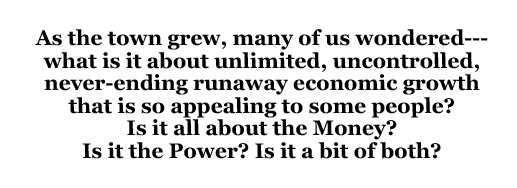
In addition to the changes that were occurring to the business district, the development of residential housing projects accelerated in the mid-90s, driven by a market that could never seem to be satisfied. All the vacant houses that had been gobbled up for pennies on the dollar in the late-80s by savvy investor/mountain bikers from California or Colorado now created a shortage in a town that had only recently become hip. Not only did the price of existing real estate skyrocket, ground was broken on one condo development after another. They all had such lovely names:
….Solano Vilejo….Mill Creek Pueblos….Coyote Run…Orchard Villa…
“Daddy, why do they call our home ‘Orchard Villa?’”
“Because, son, there used to be an orchard here.”
(Long pause)
“Daddy…what’s an orchard?”
As the town grew, many of us wondered— what is it about unlimited, uncontrolled, never-ending runaway economic growth that is so appealing to some people? Is it all about the Money? Is it the Power? Is it a bit of both? Where is the thrill in taking a horse pasture and turning it into a parking lot? Among the promoters of economic development, surely some of them are earnest citizens who feel a robust expanding economy is always a benefit to the community and that it offers the promise of a stable future by providing an ever-expanding tax base. To think otherwise is blasphemy to most capitalists.
May God forgive them for their ignorance.
An increased tax base in small rural communities rarely reduces individual tax burdens. The exact opposite is more likely to occur. This is my mantra. How many times do I have to say it?
An expanded tax base rarely reduces individual tax burdens.
An expanded tax base rarely reduces individual tax burdens.
An expanded tax base rarely reduces individual tax burdens.
An expanded tax base rarely reduces individual tax burdens.
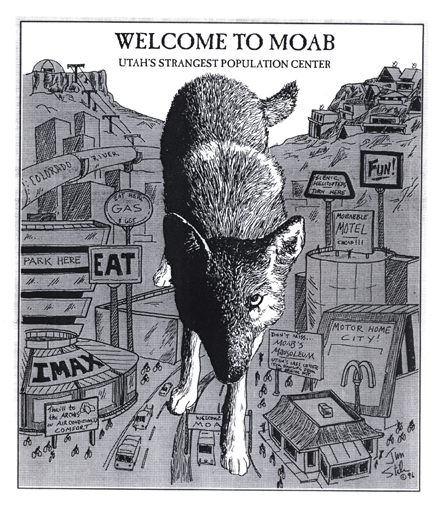 Small towns across America have often come too late to the same conclusion. According to the American Farmland Trust, for every dollar paid in property taxes, the average U.S. urban resident uses $1.36 in public services, while the average farm uses only $.21 in similar services. That’s a remarkable gap.
Small towns across America have often come too late to the same conclusion. According to the American Farmland Trust, for every dollar paid in property taxes, the average U.S. urban resident uses $1.36 in public services, while the average farm uses only $.21 in similar services. That’s a remarkable gap.
In the end, it’s simply a matter of different visions…different dreams. About 15 years ago, Tom Shellenberger, a transplanted realtor/developer from Park City, Utah, told a writer for Salt Lake City Magazine that I “had a closed mind when it comes to progress.” He concluded that we probably define the word differently, and felt that I picked on him for his pro-development views. But he also said I condemned anybody who didn’t wear Birkenstocks and that’s where I draw the line. I’ve never worn Birkenstocks a day of my life…I’m a Redwings kind of a guy. Ol’ Dutch Gerhardt, a former cowboy/dozer operator/ wise ass once explained the difference between ‘hippie boots’ and cowboy boots.’
“With cowboy boots,” Dutch explained, “the shit is on the outside.”
But I realized that Shellenberger was right in one respect–-when it came to Progress, we did define the word differently. There is a difference between Progress and Development, although it’s surely a subjective distinction. I can only speak for myself, but this is how I separate Progress from Development…
When I think of Progress and what it means for a town and its surroundings, I think of a community in which its citizens can earn a decent living, pay the bills, and have something left over at the end of the month. But I can call it Progress only when those citizens also realize the value of the intangible qualities that make our town unique and enrich our lives.
Qualities like the beauty and solitude of the canyons and mountains that surround us and qualities like the friendship, compassion and trust of our neighbors are, to me, just as important as the bottom line on a financial statement.
Progress is maintaining our small town atmosphere while recognizing that some change is inevitable, and that change can sometimes even be an improvement. Development is when the greed of its citizens allows uncontrolled growth that destroys all the qualities of small town life—the qualities that brought many of us here in the first place.
Progress is a business that flourishes and expands to meet a growing demand, while still maintaining the quality that created its success in the first place. Its success is due to the owners’ talent and hard work; expanding the business is the reward for their efforts.
Development is an out-of-town investor who sees there’s money to be made and throws up another fast food franchise, taking business and customers away from the local cafes that had flourished for years and years.
Progress is the effort by local citizens to stay loyal to those well-established restaurants. Development is locals abandoning them in droves for the franchise chains, in order to save a few cents.
Progress is a new business that comes to town and offers a new service or product that we truly need and could not obtain before. Development is another T-shirt shop with an absentee owner.
Progress is suitable housing for all its citizens. Development is another tacky condo development for wealthy out-of-towners looking to invest in a second home and hoping to turn a tidy profit.
Progress is the County Council and the Nature Conservancy saving the Mayberry Orchard. Development is seeing most of Grand County’s other orchards turned into subdivisions.
Progress is appreciating the value of the spectacular view we all enjoy of the West Wall each day. Development is a chairlift running up its sandstone flanks.
Progress is our species recognizing the value, the absolute necessity for preserving what’s left of our wild pristine country. Development is seeing it bulldozed under. Or perhaps worse, seeing those special places trampled under the feet of hordes of well-meaning people who claim they do recognize the value of wild lands but don’t recognize that their sheer numbers are destroying it.
Progress is the mountain biker who gets tired of staring at his knuckles, the bike handlebars, and three feet of ground ahead of him, and stops and looks around, and is overwhelmed by the silence and the beauty of the canyons. Development is painting more white lines on the Slickrock Trail so nobody has to stop and look around.
Progress is appreciating the fading light on the slickrock palisades above the valley. Development is ridgeline housing.
Progress is moving to Moab, wanting to be a part of the community and wanting to contribute something to it. Development is moving to Moab and seeing what can be taken from it.
Progress, in short, is Moab the Community. Development, in a nutshell, is Moab the Population Center. What’s the difference? It’s everything.
To read the PDF version of this article, click here.
Don’t forget the Zephyr Ads! All links are hot!

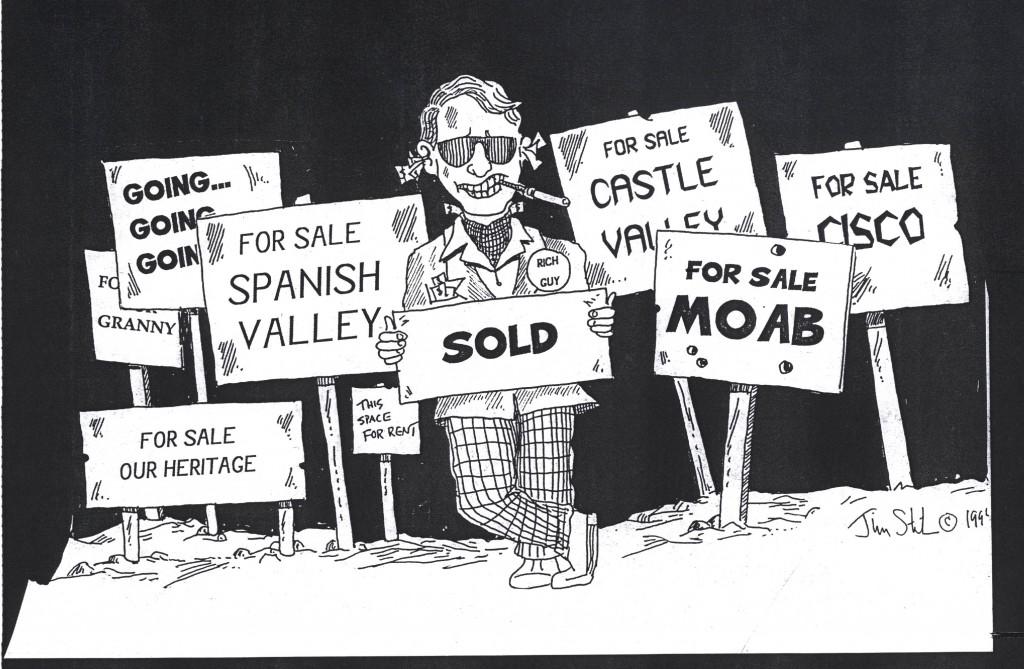
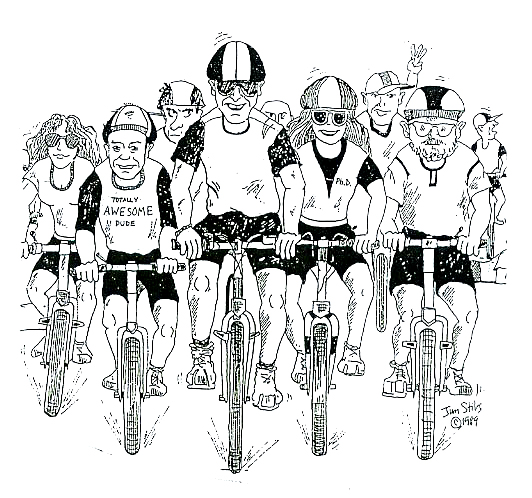
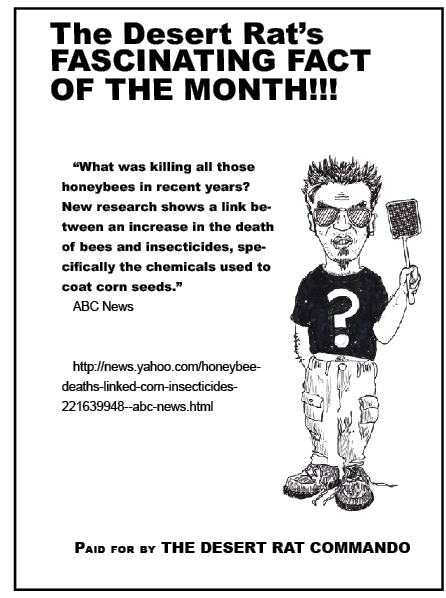

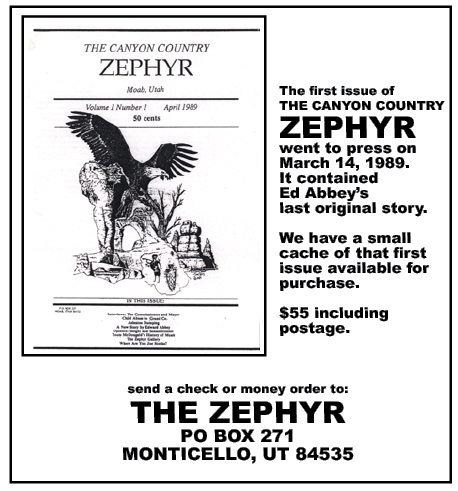
How would Moab be different if people made a commitment to live in homes that are modest in size and appearance? And if no one bought a home there without actually living in it? What if the visitors coming in went to wild areas seeking spiritual solitude instead of adrenaline spikes? These are the kind of issues that are glossed over.
I visited Moab a number of times in the late 80’s and early 90’s. Yes, I came to ride my bike and go for hikes and take photos and float the river. I lived in my Subaru for a month one chilly February, camped out at Big Bend, where I had the place largely to myself. Moab’s “other arches” had just opened up and you could literally smell the change in the air. I started to get an idea about the difference between “travel” and “tourism.” It was largely the same notion as your contrast of “progress” with “development,” coming down mainly to a regard or a disregard of any notion of place or history.
I don’t have any answers or conclusions. Just wanted to say that not all who visited came to develop and profit (financially, anyway).
I do disagree a little with Scott’s comment above, though. If your visit to a wild place doesn’t include a good adrenaline spike or two, you’ve missed something or didn’t go in deep enough.
Hey Jim progress is the nature conservancy letting the Mayberry orchard die,and then selling it to another developer
Hey Jim progress is the nature conservancy letting the Mayberry orchard die,and then selling it to another developer?? Also I would like to repeat a quote from Buffy St. Marie for Fred. “Virgin Places don’t mean a thing to people who never bring their hearts along.” I don’t need a spike of adrenaline to enjoy a desert sunrise or sunset, or to listen to the roar of silence “slow down your movin to fast”